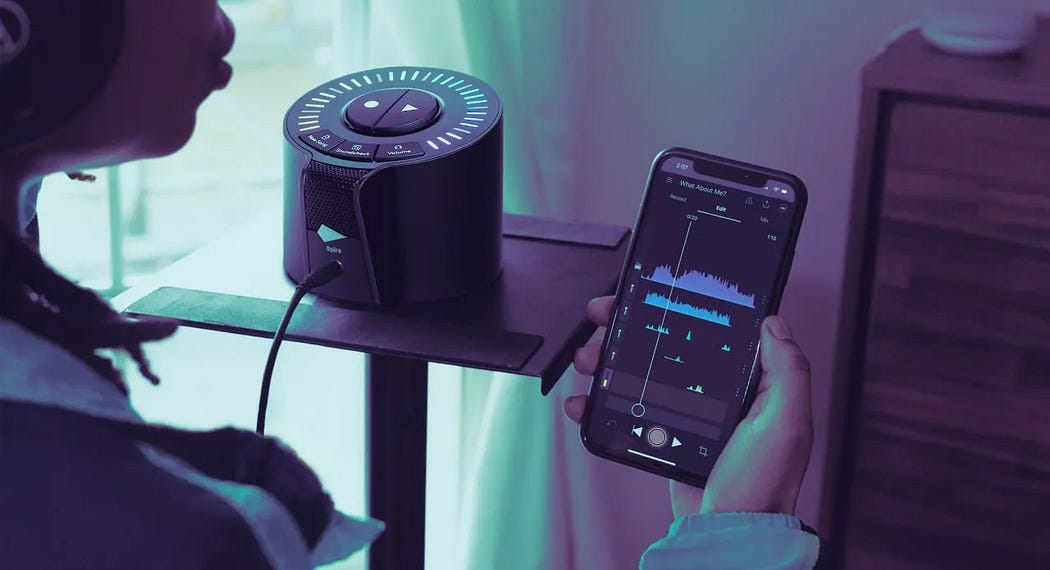
Smartphones have revolutionized the way music is created, allowing musicians to record high-quality tracks without the need for expensive studio time or complex equipment.
Whether you’re a budding artist, a professional musician, or simply someone who enjoys creating music as a hobby, recording on your smartphone can be an efficient and cost-effective solution.
In this guide, we’ll walk you through the steps and tools you need to record music on your smartphone.
Step 1: Choose the Right Recording App
The first step in recording music on your smartphone is selecting a high-quality recording app. Many apps offer features like multitrack recording, audio editing, and effects. Here are a few popular options:
- GarageBand (iOS): A powerful app that allows you to record multiple tracks, mix, and edit audio. It’s beginner-friendly and comes with a variety of built-in instruments.
- BandLab (iOS & Android): A free app with cloud-based collaboration features. It offers multitrack recording, real-time effects, and an easy-to-use interface.
- FL Studio Mobile (iOS & Android): This app is ideal for advanced users looking for professional music production. It includes a variety of virtual instruments and effects.
- Audio Evolution Mobile (iOS & Android): A versatile app offering multitrack recording, MIDI instruments, and support for external hardware.
Step 2: Use an External Microphone for Better Sound Quality
While smartphones have built-in microphones, they are not optimized for professional music recording. To achieve higher sound quality, consider investing in an external microphone that connects directly to your smartphone.
Here are a few recommended options:
- Shure MV88 (for iOS devices): A compact microphone that connects directly to your iPhone, providing superior audio quality for vocals and instruments.
- Rode VideoMic Me (for iOS and Android): A directional mic that enhances sound clarity by minimizing background noise.
- IK Multimedia iRig Mic Studio: A USB condenser microphone that works with both iOS and Android, delivering studio-grade sound for your recordings.
Step 3: Select a Quiet Location for Recording
Even with an external microphone, the recording environment plays a significant role in the quality of your music. To ensure clean, professional audio, record in a quiet location with minimal background noise.
- Choose a quiet room: Avoid rooms with too much ambient noise or echo. Recording in a smaller, carpeted room can help reduce unwanted noise.
- Use soundproofing materials: If possible, use foam panels or blankets to reduce sound reflection in your recording space.
- Microphone isolation shields: If you’re recording vocals or acoustic instruments, consider using an isolation shield to block out background noise.
Step 4: Set Up Your Equipment
Now that you’ve chosen your app and microphone, it’s time to set up your recording equipment.
- Connect your microphone: Plug your external microphone into your smartphone via the headphone jack, USB, or Lightning port (depending on the microphone and device).
- Mount your phone: Use a tripod or stand to keep your smartphone steady during the recording process, ensuring consistent sound capture.
- Monitor your sound: Use studio-quality headphones to monitor your audio while recording. This helps you detect any noise or issues in real-time.
Step 5: Start Recording
Once everything is set up, you can begin recording. Follow these basic steps for a successful session:
- Open your recording app: Launch the app you’ve chosen and create a new project or track.
- Adjust input settings: Check the app’s settings for microphone input levels, and adjust them as needed to avoid distortion or clipping.
- Record your music: Hit the record button and start playing or singing. You can usually record multiple takes or layers, depending on the app.
- Pause and review: After recording, listen back to your track to ensure the sound quality meets your expectations.
Step 6: Edit and Mix Your Track
Most recording apps offer a range of editing tools to help refine your track. You can:
- Trim and cut: Remove any unwanted sections or background noise at the beginning or end of your track.
- Apply effects: Enhance your audio with built-in effects like reverb, EQ, compression, or filters.
- Mix multiple tracks: Layer vocals, instruments, and background sounds for a more dynamic track.
- Adjust volume levels: Balance the levels of each track to ensure clarity and harmony.
Step 7: Export and Share Your Music
Once you’re satisfied with the recording and edits, it’s time to export your track.
- Export in the right format: Most apps allow you to export your music in high-quality formats such as WAV, MP3, or FLAC. Choose the format that best suits your needs.
- Save to the cloud: Apps like BandLab offer cloud storage options, allowing you to access your project from multiple devices.
- Share on social media or streaming platforms: You can easily share your finished tracks on platforms like SoundCloud, YouTube, or even Instagram directly from your smartphone.
Step 8: Promote Your Music
Once your track is ready, the next step is promotion. Many apps offer integrated sharing features, allowing you to post your music directly to social media or music platforms. Here are a few tips for promoting your smartphone-recorded tracks:
- Use hashtags: When posting on social media, use relevant music-related hashtags like #MusicProduction, #IndieMusic, or #HomeStudio to increase visibility.
- Collaborate with other musicians: Use platforms like BandLab or SoundCloud to collaborate with other artists and reach a broader audience.
- Create video content: Use video apps like TikTok or Instagram Reels to create short music clips, gaining more exposure.
Additional Tools and Accessories to Improve Your Recordings
If you’re looking to take your smartphone music production to the next level, consider adding the following accessories to your setup:
- Audio Interfaces: Devices like the IK Multimedia iRig Pro I/O allow you to connect professional instruments and microphones to your smartphone.
- MIDI Controllers: For those who enjoy composing electronic music or beats, a portable MIDI controller like the Alesis V25 can be a valuable tool.
- Studio Monitors: While headphones are useful for tracking, studio monitors like the PreSonus Eris E3.5 can provide accurate sound for mixing and mastering.

Essential Smartphone Accessories for Music Production
Your smartphone is already a powerful tool, but with the right accessories, it can easily replace much of the gear you’d find in a traditional studio. Below are some top-rated products that will enhance your mobile music production experience.
1. Shure MV88 Portable iOS Microphone
Key Features:
- High-quality stereo recording
- Plug directly into iPhones and iPads
- Comes with the free ShurePlus MOTIV app for recording and editing
- Compact and durable, making it ideal for on-the-go recording
Description: If you’re serious about sound quality, the Shure MV88 microphone is a must-have for any musician using a smartphone.
Unlike built-in phone mics, this microphone captures detailed and clear audio, perfect for vocals and acoustic instruments.
Whether you’re recording in a studio or outdoors, this portable mic ensures your sound stays crisp and professional.
Check out the range of microphones: https://amzn.to/47ZVtp7?tag=thanuaffiliat-21
2. IK Multimedia iRig Pro I/O Audio Interface
Key Features:
- Professional audio interface for iOS and Android devices
- Works with all instruments, microphones, and MIDI devices
- High-definition 24-bit/96kHz audio
Description: The iRig Pro I/O transforms your smartphone into a professional studio interface. It allows you to connect guitars, microphones, or keyboards to your mobile device, ensuring zero-latency sound recording. With this, you can plug in your instruments and capture studio-quality audio directly on your smartphone.
Check out Audio Interface: https://amzn.to/47LAZ2X?tag=thanuaffiliat-21
3. Aokeo Professional Studio Recording Microphone Isolation Shield
Key Features:
- Helps eliminate background noise during recording
- Lightweight and portable design
- Easy setup for any recording environment
Description: If you’re recording in a less-than-ideal space, an isolation shield can make a huge difference in the sound quality. The Aokeo Isolation Shield reduces unwanted noise and room echo, giving your recordings a clean, professional sound even if you’re working from home or in a noisy environment.
Check out the Professional studio microphone: https://amzn.to/4eqcye3?tag=thanuaffiliat-21
4. Mpow Over-Ear Wired Studio Headphones
Key Features:
- High-precision sound for recording and mixing
- Comfortable and adjustable design for long sessions
- Compatible with all devices
Description: No studio setup is complete without a great pair of headphones. The Mpow Over-Ear Wired Headphones offer clear, accurate sound, allowing you to hear every detail of your recording. They’re also perfect for mixing tracks and ensuring your music sounds just right before distribution.
Check out for studio Microphone: https://amzn.to/3XCjHAO?tag=thanuaffiliat-21
5. Alesis V25–25 Key USB MIDI Keyboard Controller
Key Features:
- 25 full-size velocity-sensitive keys
- USB-powered for plug-and-play with your smartphone or tablet
- 8 velocity-sensitive pads for beat-making
Description: For musicians who like to create beats or experiment with synths, a MIDI controller like the Alesis V25 is essential. This compact controller is easy to connect to your smartphone, giving you control over various instruments and sounds. With this, you can compose, perform, and produce tracks effortlessly.
check out: https://amzn.to/4diiZ1q?tag=thanuaffiliat-21
#MusicProduction
#MobileMusic
#SmartphoneRecording
Comments
Post a Comment